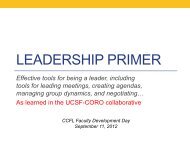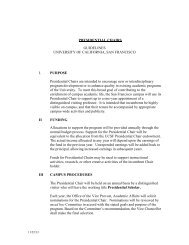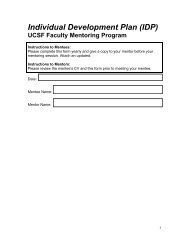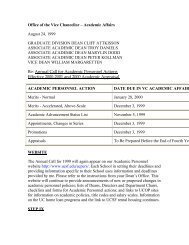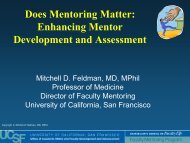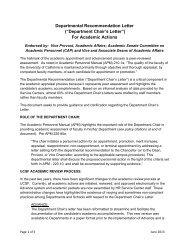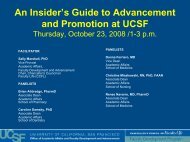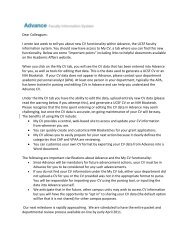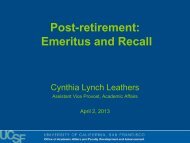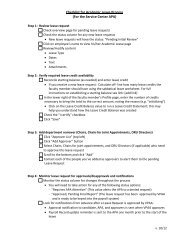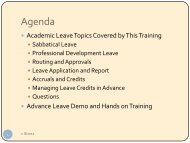Presentation - Academic Affairs
Presentation - Academic Affairs
Presentation - Academic Affairs
You also want an ePaper? Increase the reach of your titles
YUMPU automatically turns print PDFs into web optimized ePapers that Google loves.
<strong>Academic</strong> PersonnelOverview for RMSCynthia Lynch LeathersAssistant Vice Provost, <strong>Academic</strong> <strong>Affairs</strong>November 15, 2012
Requested Topics• <strong>Academic</strong>s: "who's in and who's not" regarding various titles (likeSpecialists)?• A basic overview of titles / steps / series and how advancement works(merits, promotions).• Clarification on the Specialist series and the salary scale associated withthe Specialist series (vs Prof Res Series)• From Cynthia’s point of view, it would be good to know what academicsmisunderstand regarding their titles, for example, without salary (WOS) andEmeritus appointments.• Advancement scenarios
Who are academics?UCSF Employees and Students as of October 2012(numbers rounded to the nearest hundred)Staff18,000Senate Faculty1,300Students,Residents,Postdocs6,000<strong>Academic</strong>s3,300Non-SenateFaculty1,200Non-Faculty<strong>Academic</strong>s800While all faculty are academics, not all academics are faculty!
<strong>Academic</strong> Appointments:What’s in a title?<strong>Academic</strong> Titles include:– Series: term assigned to a group of individuals with acommon competency set• e.g., Ladder rank, In Residence, Clinical X, Health SciencesClinical, Adjunct, Professional Research, Specialist, etc.– Rank: Level of Appointment• e.g., Junior, Instructor, Assistant, Associate, Full– Step: level within a rank (not included in ‘spoken’ title)• e.g., Step I, Step II, Step III etc.
Faculty – Who are They?• Have responsibility for teaching, often in conjunction with conductingresearch in their departments, ORUs, Interdisciplinary Centers oreven on other UC Campuses• Usually have “Professor” or “Instructor” in title• Often members of a compensation plan within a department• Some hold membership in the <strong>Academic</strong> Senate
Faculty – Which Series?Four criteria/competencies for faculty appointment andadvancement:• Teaching• Research/Creative Activity• Professional Competence• University/Public ServiceEach series has expectations regarding each of thesecriteria
UCSF Faculty in Each Series(10/12)Series# FacultyLadder Rank 366In Residence 498Clinical “X” 405HS Clinical 838Adjunct 390
Ranks within Series
Other FacultyAppointment Types• Acting (e.g., Acting Assistant Professor)• Lecturer• Visiting (e.g., Visiting Assistant Professor)• Emeritus (e.g., Professor Emeritus)• Recall (e.g., Professor FY Recalled)
Non Faculty <strong>Academic</strong>s– Who are They?• Non-faculty academic employees participate inresearch programs, ORUs or InterdisciplinaryCenters & Programs but do not provideteaching, although they may provide training inthe laboratory setting• Non-faculty academics are not members of acompensation plan in a department• They do not hold membership in the <strong>Academic</strong>Senate
# UCSF Non-Faculty <strong>Academic</strong>sin Each Series(10/12)Series#appointeesProfessional Research Series 150Specialists 604<strong>Academic</strong> Administrators 21<strong>Academic</strong> Coordinators 56
Ranks Within Non-Faculty <strong>Academic</strong> Series
Other Non-Faculty <strong>Academic</strong>Series• Librarian Series• Project Scientist Series (not used at UCSF)• Post-Doctoral Appointees, Fellows, <strong>Academic</strong> StudentEmployees
14Professional DevelopmentTrainingPerformanceSolutionsUCSF Human Resources Development & Training
http://academicaffairs.ucsf.edu/
What are the Types ofAdvancement?• Promotion– From one Rank to another (i.e. Assistant toAssociate)• Merit– From one Step to another (i.e. Step I to Step II)* Exception for advancement from Professor Step 5 to Step 6 andProfessor 9 to Above Scale in all series (although technically amerit, the checklist criteria is same as promotion)
Criteria for Normal/On-timeAdvancement: MeritNormal/On-Time Merit Advancement– Every 2 years for Assistant rank– Every 2 years for Associate Rank Step 1-4– Every 3 years for Associate rank Step 4-5– Every 3 years at Professor Rank Step 1-9– At least 4 years at Professor Step 9 before eligible for AboveScale Merit (additional materials required)– No requirement for further Above Scale Advancement but ifconsidered, must be at least 4 years AND must be exceptionalperformance (not simply years of service)
Criteria for Normal/On-timeAdvancement: Promotion• Instructor to Assistant– 2 years (if MD, must be boarded before eligible to advance)• Assistant to Associate Professor– 6, 7 or 8 years at rank (at steps 1, 2, 3, &/or 4)• Associate Professor to Professor– 6 years at rank (at steps 1, 2 and &/or 3)
Criteria for AcceleratedAdvancement• What is Accelerated Advancement?– Advancing faster – e.g. a 1-year movement to next eligible rank/step OR– Advancing further – e.g. advancing 2 steps at once• Why is it important?– Recognition of exceptional faculty performance over a sustainedperiod of time• How does it happen?– Proposed by: any member of faculty, department chair, orcandidate him or herself
Possible Advancement Scenario
Requested Topicsü <strong>Academic</strong>s: "who's in and who's not" regarding various titles (likeSpecialists)?ü A basic overview of titles / steps / series and how advancement works(merits, promotions).• Clarification on the Specialist series and the salary scale associated withthe Specialist series (vs Prof Research Series)• From Cynthia’s point of view, it would be good to know what academicsmisunderstand regarding their titles, for example, without salary (WOS) andEmeritus appointments.ü Advancement scenarios
Questions?This slide deck will be available onthe <strong>Academic</strong> <strong>Affairs</strong> Website:http://academicaffairs.ucsf.edu/
APPENDIXDetails on Faculty andNon-Faculty <strong>Academic</strong> Series
Professor/Ladder Rank Series• Expected to achieve distinction in all 4 competencies• Assigned a 1.0 state-funded FTE• Granted tenure when they reach Associate Professor rank or above• Eligible for sabbaticals• Member of the <strong>Academic</strong> SenateTitles:Assistant Professor of __ (dept)__Associate Professor of __ (dept)__Professor of __ (dept)___
In Residence Series• Same expectation as ladder rank: achieve distinction in all 4competencies• Do not have an assigned state-funded FTE, but may have salarysupport from state funds• At UCSF, have 1-year salary commitment at Assoc/Full Professorrank• Members of <strong>Academic</strong> SenateTitles:Assistant Professor of __ (dept)__ In ResidenceAssociate Professor of __ (dept)__ In ResidenceProfessor of __ (dept)___ In Residence
Clinical “X” Series• Series established to recognize outstanding clinicianscholars.• Expected to achieve distinction in teaching/mentoringand “creative activity”• Must disseminate creative activity for appointment oradvancement• Members of <strong>Academic</strong> SenateTitles:Assistant Professor of Clinical __ (X=dept) __Associate Professor of Clinical __ (X =dept) __Professor of Clinical __ (X=dept) ___
Health Sciences Clinical Series• Salaried faculty in health sciences who primarily teach in clinicalprograms; participate in patient care, and engage in some scholarlyactivity• Research and creative work are desirable and encouraged but notrequired to advance• Not members of the <strong>Academic</strong> Senate• Appointments can be full- or part-time, and are subject to annualrenewalTitles:Health Sciences Assistant Clinical Professor of __(dept)__Health Sciences Associate Clinical Professor of __(dept)__Health Sciences Clinical Professor __(dept)___
Adjunct Series• Requires excellence in at least one, and preferably morethan one, of 4 competencies• Exceptional achievements in one area may compensatefor less activity in another area, i.e., a balance in all fourcategories is not required• Appointments can be full- or part-time, and are subject toannual renewal• Not members of the academic senateTitles:Assistant Adjunct Professor of __(dept)__Associate Adjunct Professor of __(dept)__Adjunct Professor __(dept)___
Clinical Professor Series,Volunteer• community volunteer clinicians• teach the application of clinical and basic sciences inareas of patient care• a valuable way to utilize the interest and expertise ofpractitioners from the community on a part-timeunsalaried voluntary basis in the areas of teaching,patient care, and clinical research.
Professional Research Series• Responsibilities include making significant creative and/or technical contributions to a research activity• Appointees do not have teaching responsibilities• Eligible for PI status• Ability to secure independent funding does notautomatically qualify individuals for appointment to thisseries
Professional Research SeriesExampleDr. D’s research is in the genetics of cancer and he hasbeen an enormous asset to our research effort toelucidate the molecular mechanisms involved in multiplepathways of colorectal carcinogenesis. He has been anexcellent mentor to 4 research fellows, having guidedthem in a very fruitful research fellowship experience.
Specialist Series• Narrow focus in specialized area• Provides technical or specialized expertisein planning and execution of a researchproject– Instrumentation & research equipment– Social science research methods• Terminal degree not required
Specialist SeriesExamples• Dr. S is an expert on 3-dimensional fluorescence microscopy;writes computer code to integrate the many motors andinstruments to work together; develops code to build userlevel graphics and advise users so that data collection withbiologists is optimal• Mr. H’s responsibilities include conducting ethnographicresearch including in-depth interviews with local and federalpolicy-makers, locating and retrieving legislative testimony
<strong>Academic</strong> Coordinator Series• Administers academic programs thatprovide service closely related to teachingor research mission of University• This service may be provided to– academic departments– students– general public
<strong>Academic</strong> Coordinator SeriesExamples• Ms. D serves as co-director and is responsible for theoverall operation of the specimen bank, including fiscalmatters• Mr. G is the program director of ABCD which is a jointventure of Kaiser and the Dept of X to perform researchand evaluations on quality improvements in primary care
<strong>Academic</strong> Administrator Series• Duties more in administration than in teaching and/orresearch, although administration may includeparticipation in, as well as overseeing programs involvingteaching, research, or academically-based public service– If oversee research program, may/may not engage inresearch. Engaging in research is desirable, but not impliedby appointment• As a normal requirement, the appointees should havethe terminal or top degree in his/her field
<strong>Academic</strong> Administrator SeriesExamples• Dr. B’s responsibilities will be to partner with industry clients to conductcutting-edge research in the Bioengineering Modeling Program; she willdesign experiments that make the best use of the instruments, managebudget and cost recovery for instrument-related expenses and perform dataanalyses• Dr. C plans, coordinates and implements academic partnerships andprofessional development programs to support SEP outreach activities.SEP is a nationally-recognized program that support K-12 scienceeducation through partnerships between UCSF volunteers and teachers inthe SF Unified School District• Dr. S is the director of the office of research in the School of X;Responsibility is to expand services in response to developments ininformation technology and program evaluation software as well as HIPAApolicies that govern electronic data transfer and storage



